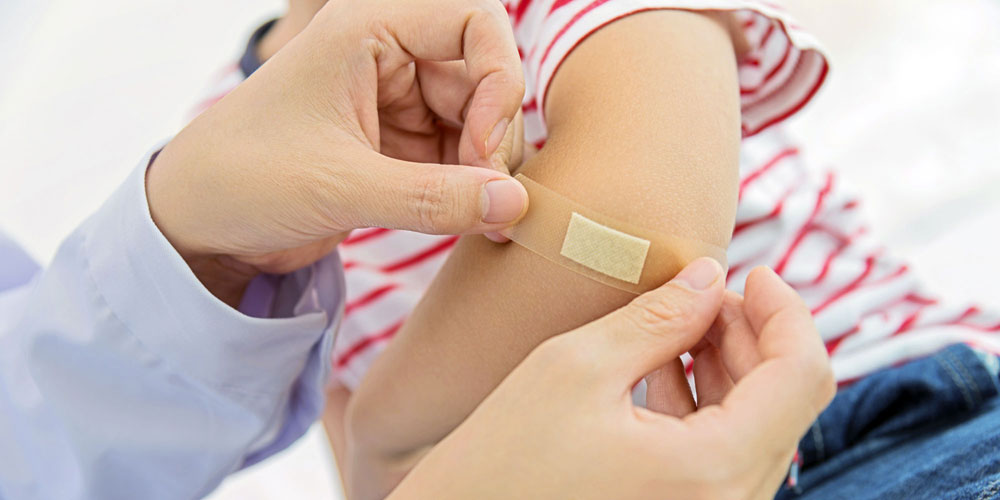The varicella zoster virus causes chickenpox. More information on symptoms, contagion and treatment of illness

Chickenpox: The rash occurs about two to three weeks after being infected
Chickenpox – in a nutshell
A typical rash for chickenpox is red spots, blisters and eschar spots – the so-called "starry sky". Chickenpox during pregnancy is dangerous for the baby. The virus is highly contagious and can be spread to others a day or two before the rash occurs. About a week after the start of the rash, the blisters are scabbed and visits to community facilities are allowed again. Vaccination can protect against the disease.
What are chicken pox?
Chickenpox (varicella) is a highly contagious viral disease. The main symptoms are a rash with red spots and blisters all over the body and a mild fever. Rare, but possible complications include pneumonia or meningitis and bacterial infection of the vesicles. Years later, shingles can result from viruses remaining in the body. The disease has become much rarer since the vaccination recommendation in 2004.

Causes and contagion
The varicella zoster virus (VZV) is the causative agent of chickenpox. It belongs to the herpes virus and is so contagious that most people were infected with the pathogen as children before the vaccine was introduced. Once you are ill, you are usually protected against the virus for life. For this reason, chickenpox was one of the teething troubles. However, adults who have not had chickenpox or have not been vaccinated against it can get the disease.
The transmission takes place over the air (the "wind") due to droplet cores containing viruses, which are excreted by sick people when breathing and coughing and which can cause people to become infected within a radius of several meters. The content of the blisters on the skin is also infectious.
The disease is contagious a day or two before the rash occurs. The risk of spreading is greatest in the next two to three days, while new bubbles are constantly being added. A good five days after the last relapse, when the blisters are completely scabbed, the patient no longer poses a risk of infection. Only then – about a week after the onset of illness – are they allowed to visit community facilities such as schools and kindergartens again in accordance with the Infection Protection Act. A written certificate is not required.
A shingles can only be infected with chickenpox via the blister contents. This means that it is usually sufficient to cover affected areas with clothing.

symptoms
The incubation period is between eight days and three weeks. The typical rash usually occurs about 14 to 16 days after infection. Sometimes he is preceded by an indefinite feeling of sickness with headache, loss of appetite and mild fever, but this is often not noticed.
Suddenly red spots and itchy blisters appear. If you could first think of mosquito bites, the spread of the rash to parts of the body that are actually covered with clothing will make the diagnosis easier. The blisters can also appear under the eyelids, on the oral mucosa, the hairy head and the genital organs. Since mostly red spots, blisters and already opened blisters are visible at the same time, one speaks of the image of "starry sky". There is usually only a slight fever.
complications
Bacteria such as staphylococci and streptococci are always present unnoticed on our skin. If the vesicles are opened, they can lead to infections, so that antibiotic therapy may be necessary. If the patient scratches the blisters, scars can form later.
Pneumonia caused by the chickenpox virus cannot be treated directly. It occurs about three to five days after the onset of the disease and is significantly more common in adults than in children. Inflammation of the cerebellum (cerebellitis), which usually shows up with balance disorders, can occur acutely, but only three weeks later. Inflammation of the brain (encephalitis) or changes in the blood vessels or even a stroke in the child are very rare. In individual cases, complications such as myocarditis, changes in the cornea of the eye, kidney inflammation, inflammation of the joints, tendency to bleed and inflammation of the liver can occur.

Chickenpox in pregnancy
Chickenpox is a danger to the unborn during pregnancy. If an expectant mother falls ill before the 20th week of pregnancy, the child is at one percent risk of harm. Brain damage, limb malformations, growth disorders or a congenital cataract (cataract) can occur.
If the mother is infected five days before or two days after the birth date, the risk of illness for the child is particularly high. Special treatment measures are necessary for the so-called newborn varicella (see section "therapy"). The course is particularly difficult with such small babies and the risk that the child dies from the disease is about 20 percent.
Women who want to have children who are not vaccinated against chickenpox should therefore be vaccinated, at least four weeks before trying to conceive. Because in pregnancy, vaccination against chickenpox is not allowed. After contact with chickenpox, however, antibodies against the virus can be administered. Pregnant women who have come into contact with varicella should therefore contact their gynecologist quickly.
diagnosis
The doctor usually recognizes chickenpox by the way the rash looks and how it spreads over the body. Antibodies to the varicella zoster virus (VZV) can later be detected in the blood.
The direct detection of the viruses from the bladder secretion is also possible. This is done using the polymerase chain reaction (PCR) method. To do this, the genetic material DNA is duplicated in the test tube. With this method, a quick detection of chickenpox viruses is possible, but it is only indicated in isolated cases. For example, it can be important for an expectant mother when it comes to artificially delaying the birth due to chickenpox disease for a few days or initiating special therapy.

therapy
The normal course of the disease is primarily about alleviating the itching. If the patient scratches the blisters, infections are more likely and scars remain. For a long time, a zinc shake mixture for dabbing has proven itself in chickenpox, it helps the blisters to dry out. The sick child’s fingernails should be cut short. Medications for itching, so-called antihistamines, as are known from allergy treatments, are available in drops, for example. If necessary, ask your doctor to recommend a suitable preparation and be sure to pay attention on the correct dosage!
In the case of fever or pain, agents with the active ingredients paracetamol or ibuprofen in the dosage appropriate for the weight of the child help. If in doubt, talk to your doctor or pharmacist about which medication is right for your child.
Chickenpox is strictly forbidden to be given acetylsalicylic acid (ASS), because this is the life-threatening Reye syndrome (read: "Rei syndrome") can come with brain and liver damage.
If a baby falls ill shortly before or after birth, there is an urgent need for treatment. Before birth, the mother-to-be receives special immunoglobulins within one to three days of the possible infection, which are already finished antibodies against the varicella-zoster viruses. This is to give the unborn child some protection along the way. After birth, the antibodies are injected into the baby. In addition, it usually receives an anti-viral drug (active ingredient acyclovir), especially if it already shows symptoms of illness.
The preventive administration of antibodies against the virus after contact with a sick person can also be useful in patients with a weakened immune system, such as cancer patients or patients with immune deficiencies.

vaccination
Without effective vaccination, varicella-zoster viruses cause almost 43,000 complications annually, around 5700 of the patients have to be hospitalized and 25 to 40 die. Therefore, according to the STIKO recommendation from 2004, all infants between the ages of 11 and 14 months and between the ages of 15 and 23 months should not only be vaccinated against measles, mumps and rubella (MMR), but also against chickenpox. This is also possible with a quadruple vaccination: the MMRV vaccination. The minimum interval between the two vaccinations is four to six weeks. Older children and adolescents should also receive two vaccinations up to their 18th birthday if they do not have chickenpox. This also applies to adults who have not yet been immunized and who are particularly at risk, such as women who want to have children and People with an immune deficiency or severe neurodermatitis.
RELATED ITEMS
-

Language training: when is therapy necessary? Baby and family
Lispel, stuttering, selective mutism – more and more children have speech disorders and receive speech therapy. The Munich explains the background…
-

Child snores – what to do? Baby and family
Not only adults snore. Even small children can saw like world champions. What is behind it – and when it gets dangerous That parents…
-

Which houseplants are poisonous? Baby and family
They are not only beautiful, but sometimes also poisonous or prickly: houseplants. What parents should consider when choosing to have their child…
-

Autism: more children affected than before – baby and family
More and more children are diagnosed with autism. Many are said to suffer from Asperger’s syndrome in particular. Why the numbers are rising, what symptoms…
